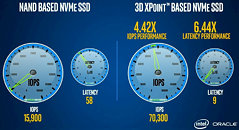Thursday, October 29th 2015

Intel Shows Off Optane 3D XPoint SSD and SSD-DIMM Implementation
At the Oracle OpenWorld conference, Intel took the opportunity to show off its latest implementation of the revolutionary 3D XPoint memory technology, which aims to replace NAND flash as the staple high-performance solid-state storage technology; offering exponential gains in density and performance. Optane, codename for Intel's upcoming 3D XPoint SSD based on conventional storage interfaces (PCIe M.2, U.2, PCIe add-on card) and the modern NVMe protocol; was demoed on Oracle's X5-2 series 1U server, where it clocked 4.42 times the random access performance, and 6.44 times better latency, than the fastest NAND flash based SSD in those form-factors. Optane promises 7.13 times the throughput when used with Oracle software.
That was only part of the presentation. The other being an audacious new contraption, a prototype 3D XPoint based SSD in the DDR4 DIMM form-factor. Intel envisions high-capacity SSD storage to eliminate most system-level bottlenecks, and talk directly to the processor's integrated memory controller. System builders will be able to combine DDR4-DRAM memory modules with Optane DIMM modules over vacant channels, and end up with the lowest possible latency storage interface. According to Intel CEO Brian Krzanich, Optane DIMM modules will be the closest that storage will have ever gone to the performance levels of DRAM, and should greatly accelerate in-memory database implementations.
Source:
ThePlatform.net
That was only part of the presentation. The other being an audacious new contraption, a prototype 3D XPoint based SSD in the DDR4 DIMM form-factor. Intel envisions high-capacity SSD storage to eliminate most system-level bottlenecks, and talk directly to the processor's integrated memory controller. System builders will be able to combine DDR4-DRAM memory modules with Optane DIMM modules over vacant channels, and end up with the lowest possible latency storage interface. According to Intel CEO Brian Krzanich, Optane DIMM modules will be the closest that storage will have ever gone to the performance levels of DRAM, and should greatly accelerate in-memory database implementations.




9 Comments on Intel Shows Off Optane 3D XPoint SSD and SSD-DIMM Implementation
Seriously tho. It looks extremely promising, but doubt very much that it will hit the consumer market any time soon. It will require extensive time in the enterprise segment before it is downgraded to "PC enthusiast/consumer" grade. At this moment in time NVMe is more than enough for most of extreme jobs you can think of. There simply not enough processing power inside CPU itself on one side and software on the other to require more.
To fully utilize benefits of NVMe or X-Point we need more lanes for starters and radically redesigned motherboards with more bandwidth than you can imagine today. Take just ordinary "slow" 750. Inside that monster sits 18 channel controller. Which means if you put enough dies on PCB x16 Gen. 3 PCI-Ex slot will be hopelessly insufficient for the task in hand. PCI Express Gen. 15 anyone?
It's funny that 15 years ago everything was totally bottlenecked by slow spinning HDDs. Today situation is totally reversed. HDDs are disappearing (slowly but surely) into oblivion and current scheme how PC is working quickly turning to be obsolete - storage is bottlenecked by everything else..
Irony of fate my friends...
Another thing; large consumer base "adoption" can't occur when a great many can't afford it.